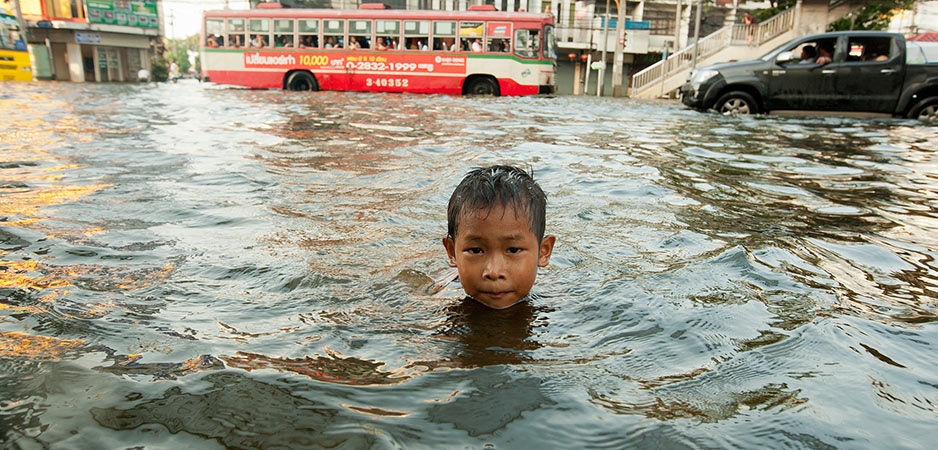The COVID-19 pandemic has been labeled a children’s disaster, with particular concern being placed on the protection of minors. In this crisis, as with other crises and disasters, children have paid a high price, with tens of millions of them affected by the lockdowns caused by the pandemic.
The majority of people impacted by disasters are children and many are also displaced due to such crises. In fact, the United Nations has declared children to be the group most affected by disasters each year. In 2018, nearly 50 million children needed protection in humanitarian settings, according to the Alliance for Child Protection in Humanitarian Action.
When COVID-19 and Hurricanes Collide
With COVID-19, protection systems have come under increasing strain as power imbalances become more acute, causing an increase of stress within families. This has aggravated the risk toward children who are at higher risk than other age groups of encountering violence, abuse, neglect and exploitation in disaster settings, including those disasters driven by climate change.
Top risks for girls and boys in disasters include physical, sexual and psychological violence; neglect; injuries; harmful practices, such as child, early and forced marriage; psychosocial distress and mental disorders; children becoming associated with armed conflicts and groups; child labor; malnutrition; trafficking; losing out on education; and becoming unaccompanied and separated.
In particular, disasters often also hamper children’s access to education, health care, birth registration and other critical governmental services. The COVID-19 pandemic, in which access to education has been severely constrained, has meant that access to vital protection systems has been difficult.
Excluding Children
Having said that, all of these risks could be reduced through specific preparedness activities prior to a disaster. However, the reality of the matter is that in many cases, youth and children are excluded from planning, response and disaster risk reduction activities. In addition, despite the danger to children, their protection risks such as those related to psychosocial well-being and resilience are not well understood or documented. There is currently no global snapshot of children’s perspectives related to protection and mental health and psychosocial issues from disasters.
While international law does not explicitly refer to child protection in disasters, the UN Convention on the Rights of the Child and other human rights instruments have set out rights that are applicable to all situations of crisis and that are relevant to the most important protection gaps that children face in disasters. This is true of the requirement that all actions concerning children must be taken according to the principle of the “best interest of the child.” The Convention on the Rights of the Child also enshrines each child’s right to express his or her views, and it requires that these views be given due weight in accordance with the age and maturity of the child.
Different national contexts and legal traditions determine whether legislative, policy or planning tools (or a combination of all three) are best suited to ensure that child protection goals are achieved. However, disaster management professionals often come to their work without clear guidance on children’s rights and special needs in disasters, and thus these issues can easily be overlooked.
Hence, there needs to be clear engagement between policymakers and those professionals to ensure that measures and responsibilities for child protection are adequately formalized and adapted to meet children’s best interests. Law and policy related to children also need to reflect the varied requirements of children of different ages and abilities.
Children and Climate Change
This is of utmost urgency and importance in the wake of climate change leading to more frequent weather-related disasters. Our world is heating up. Even as so much of our lives slow down, pause or alter from the COVID-19 pandemic, the carbon in our atmosphere continues to accumulate. With it, we know that more frequent and more intense droughts, floods, fires, population movements and public health crises will continue arriving at our doorsteps.
In just the last year alone, we have seen large-scale climate-related disasters in places as diverse as Mozambique, South Asia, the Bahamas and East Africa. This will have direct impacts on children as protection systems are affected, exacerbating preexisting tensions and conflicts. This will leave children susceptible to violence, abuse, child labor, trafficking and other forms of exploitation.
Compared to boys, girls are at higher risk of experiencing many secondary impacts that arise from disasters. These include sexual and gender-based violence, the pressure to marry as children and a loss in education opportunities. These secondary impacts may be the real “disaster” for girls. The risks are due to an intersectionality of social norms and power dynamics that lead to girls having less access to, or control over, assets including the resources necessary to cope with disasters. Such assets include access to information, education, health and wealth.
As a result, girls may suffer a “double disaster.” It is the inequities in the everyday, and not just in times of disaster, that increase risk and reduce life chances for girls. Amplifying this has been the dismal investment in emergencies, with an average only $3 spent per child in need of protection for the whole of 2018.
What Can Be Done?
What the international community is doing now to protect children in disasters is clearly not enough. Too many children are being left out, left behind and being harmed. Improving the approaches that are already there will lead to some gains, but this will be nowhere near what one should expect. Thus, there is a need to do better.
There is a need to shift away from a responsive model that relies on putting out fires, hoping that the same old thinking next time will lead to different results and that humanitarians can do the heavy-lifting on our own. There is a need to move to a model that focuses on prevention. There is a need for a transformative approach.
Missing in the existing efforts — as well-intentioned as they are — has been the pursuit of genuine support to governments to develop, implement and monitor domestic laws and regulations that enable children to live in safety. This approach underlines the responsibility of governments to ensure child protection systems are in place and adequate funds are available during disasters. It also provides clarity as part of disaster preparedness on what is needed, who is responsible and what measurements need to be applied to the protection of children. This is all especially important as climate-related disasters grow in frequency, scale and impact.
Supporting governments is surely not enough alone. It is not a silver bullet, and yet it is a crucial piece that has been underutilized or even missing from our collective toolbox to protect children in disasters. This includes ensuring relevant ministries and agencies are mandated to have in place contingency plans fully covering child protection. And that child protection issues should be included in relevant laws, regulations and policies on disaster risk management.
Also needed is mandating the collection and analysis of age, gender and disability-disaggregated data as part of risk assessments. This includes improving specific content in their laws and regulations, including that related to meeting children’s best interests, being gender-responsive and drawing on necessary international minimum standards.
A recently released report from the International Federation of Red Cross and Red Crescent Societies outlines the actions governments can take to cover key protection issues and ensure better coordinated, multi-level and interactive approaches to implementing domestic laws involving child protection. In this, there are lots to think about in addressing a vital issue in terms of child protection and disaster legislation, and much more needs to be done.
The views expressed in this article are the author’s own and do not necessarily reflect Fair Observer’s editorial policy.
Support Fair Observer
We rely on your support for our independence, diversity and quality.
For more than 10 years, Fair Observer has been free, fair and independent. No billionaire owns us, no advertisers control us. We are a reader-supported nonprofit. Unlike many other publications, we keep our content free for readers regardless of where they live or whether they can afford to pay. We have no paywalls and no ads.
In the post-truth era of fake news, echo chambers and filter bubbles, we publish a plurality of perspectives from around the world. Anyone can publish with us, but everyone goes through a rigorous editorial process. So, you get fact-checked, well-reasoned content instead of noise.
We publish 2,500+ voices from 90+ countries. We also conduct education and training programs
on subjects ranging from digital media and journalism to writing and critical thinking. This
doesn’t come cheap. Servers, editors, trainers and web developers cost
money.
Please consider supporting us on a regular basis as a recurring donor or a
sustaining member.
Will you support FO’s journalism?
We rely on your support for our independence, diversity and quality.





